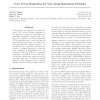Free Online Productivity Tools
i2Speak
i2Symbol
i2OCR
iTex2Img
iWeb2Print
iWeb2Shot
i2Type
iPdf2Split
iPdf2Merge
i2Bopomofo
i2Arabic
i2Style
i2Image
i2PDF
iLatex2Rtf
Sci2ools
ICML
2005
IEEE
2005
IEEE
Core Vector Regression for very large regression problems
In this paper, we extend the recently proposed Core Vector Machine algorithm to the regression setting by generalizing the underlying minimum enclosing ball problem. The resultant Core Vector Regression (CVR) algorithm can be used with any linear/nonlinear kernels and can obtain provably approximately optimal solutions. Its asymptotic time complexity is linear in the number of training patterns m, while its space complexity is independent of m. Experiments show that CVR has comparable performance with SVR, but is much faster and produces much fewer support vectors on very large data sets. It is also successfully applied to large 3D point sets in computer graphics for the modeling of implicit surfaces.
Asymptotic Time Complexity | Core Vector Regression | ICML 2005 | Machine Learning | Vector Machine Algorithm |
| Added | 17 Nov 2009 |
| Updated | 17 Nov 2009 |
| Type | Conference |
| Year | 2005 |
| Where | ICML |
| Authors | Ivor W. Tsang, James T. Kwok, Kimo T. Lai |
Comments (0)

